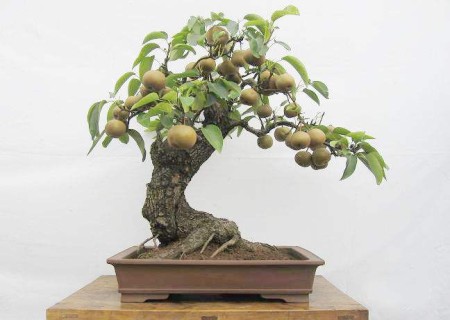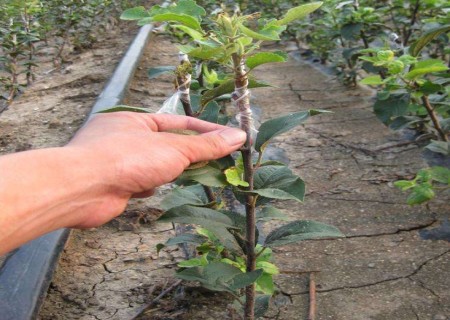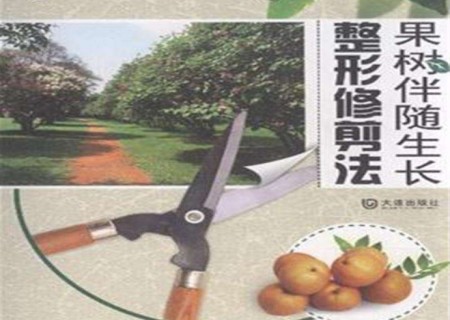Pruning principle of bonsai of fruit trees
When there are too many bonsai branches of fruit trees, it is easy to cause scattered nutrients, lack of internal light, poor fruit quality and so on. Therefore, cross branches, overlapping branches, disease and insect branches and overgrown branches should be cut off before sprouting in spring, which is called basic pruning. In the summer fruit growth period, by coring, sprouting, cutting and other means to control the tree shape, and to prevent the formation of apical dominance, to promote the growth and expansion of fruit. In autumn, in order to improve the ornamental effect of bonsai of fruit trees, we should give priority to shaping, cut off the branches that affect the ornamental effect, and remove the leaves that cover the fruit.

Physical pruning of fruit trees before sprouting in spring can assist the dwarfing of fruit trees. When the initial growth of fruit trees is too prosperous, the growth of fruit trees can be inhibited by spraying B9, PP333, dwarf and other chemical reagents. Flower buds should be cut at the right time, for flower buds are just emerging. Cut under the flowers, leaving the head and shape.
The bonsai of fruit trees has the characteristics of both shape and fruit, which is not only for people to enjoy the shape, but also for people to eat fruit. It can be said to be a good product for family planting. Bonsai pruning of fruit trees must follow certain laws and be familiar with certain theories to achieve scientific and reasonable pruning. Here are the ten principles of fruit tree bonsai pruning, please refer to:
1. Two parts
That is, the aboveground and underground parts are the crown and root system. These two parts are closely related. In the annual growth cycle of fruit trees, these two parts are in dynamic equilibrium. To a certain extent, the crown is reshaped and trimmed, and the more it is cut, the stronger the power to promote the restoration of the crown. Cutting is the branch, relying on the root, the root system is destroyed, which will inevitably affect the growth of the crown.
2. Two roads
That is, there are two ways to transport water and organic nutrients. The water and inorganic salts absorbed by the roots are transported to the crown through xylem ducts; the organic nutrients produced by leaves are transported to the roots through the sieve tubes of the cortex. Measures such as ring peeling to increase fruit setting rate, promote flower bud formation and "injure muscles and bones" (damage xylem) to weaken and slow down the growing part of the tree are all due to the destruction of the normal function of the two roads to achieve the desired purpose.
3. Two centers
For the aboveground part, the organic nutrition produced by the leaves of fruit trees during the growing period has two centers in the distribution process: one is transported to the top of the most active new shoots for growth, and the other is transported to the fruiting part for fruit growth. The transfer of nutrition to the growth center will cause the tree to be too prosperous, while the transfer of nutrition to the fruit center (too much fruit) will cause the tree to be too weak. One of the main tasks of pruning is to regulate the distribution center of organic nutrition to make its growth and fruit coordinated and suitable.
4. Two growth stages
The growth of new shoots in the annual cycle can be divided into two stages: spring shoot and autumn shoot. Spring shoots, also known as intra-bud shoots, play a decisive role in the early nutrition level of fruit trees and belong to cumulative branches; autumn shoots grow after the rainy season, which is not conducive to fruit growth and flower bud differentiation, and belongs to consumptive branches. For young prosperous trees, we can make full use of autumn shoots to achieve the purpose of light cutting, leaving and expanding the crown; for fruiting trees, how to control and weaken the growth of autumn shoots is one of the tasks of shaping and pruning.
4. Two kinds of techniques
That is, truncation and thinning, that is, cutting the branches or thinning them from the base. These are two basic techniques in fruit tree pruning. The short cut is divided into light, medium, heavy and extremely heavy cut, which is helpful to the part of the pruned branch. For the same branch, the heavier the truncation, the stronger the local auxiliary effect, and the smaller the growth of the truncated branch. The lighter the truncation, the weaker the local boost effect, and the greater the growth of the truncated branches. Thinning shear can reduce the potential of the part above the cut, but promote the part below the cut. Only when these two techniques are used properly, can the ideal pruning effect be achieved.
6. Combination of winter and summer
That is, the combination of winter pruning and summer pruning. For young trees and first fruit trees, a single pruning in winter often leads to overpruning, too much clockwork the following year, and late fruiting; if it is lightly pruned in winter and combined with wiping, picking, peeling, twisting, pulling, carving and other techniques in summer, it will accelerate crown formation, early flowering and early fruiting. The greater the amount of pruning after sprouting, the more serious the damage to the "vitality" of the tree. Therefore, summer shaping and pruning should reduce the loss of leaves as far as possible to achieve the purpose of flourishing, slow potential, early flowering and early fruiting.
7. Lifelong contradiction
That is, the contradiction between growth and fruit, which runs through the whole life cycle of fruit trees, showing the strength of the trees and the number of fruits. The law of heredity determines that all measures for young trees to grow and fail to bear fruit are achieved by weakening the tree potential.
8. Two driving forces
That is, light and water, light is energy, determines the level of nutrition and accumulation of fruit trees; water is the lifeblood and determines the growth power of fruit trees. As the saying goes, "the waterway grows well, the tree grows well, and the light road produces good results." this is the truth. The first thing to consider in shaping and pruning fruit trees is the conditions of soil, fertilizer and scenery. Only when the individual and group structure of fruit trees coincide with the ecological conditions, can the best effect be achieved.
9. Two advantages
That is, vertical advantage and top advantage, that is, the upward and topping nature shown in the growth process of fruit trees, which is the principle that all fruit trees can grow tall and grow. In the process of fruit tree shaping and pruning, adjusting the balance of upper and lower parts of the crown, external and internal growth results is essentially to adjust the relationship between the two advantages.
10. Two angles
That is, the angle of the backbone branch and the angle of the upper branch group. The angle is the "key" to adjust the light path and the waterway, adjust the two advantages, and achieve the coordination of growth and results. When the angle changes from small to large, the tree potential changes from strong to stable to weak; on the contrary, from large to small, the tree potential changes from weak to strong. The most effective measure for young trees to bear fruit early is to cut and grow lightly and open at an angle. The old tree is renewed by using the angle on its back and raising it.
Time: 2019-06-09 Click:
- Prev

Management methods of grafted seedlings of Pear trees
The growth of the grafted pear seedlings is often inconsistent because of the high density in the sowing nursery. It is best to separate the grafted semi-mature seedlings before the next spring, so as to expand the nutritional area of the seedlings. Cutting off the root system also solves the problem of overlong main root of rootstock.
- Next

Principles of standard shaping and pruning of bonsai for fruit trees
Bonsai fruit trees have ornamental value all the year round, with exquisite flowers in spring, luxuriant branches and leaves in summer, numerous fruits in autumn, vigorous and vigorous in winter, and full of interest in life. China is rich in fruit tree resources. All kinds of wild fruit trees and their rootstock resources can be used in the mountains.
Related
- Fuxing push coffee new agricultural production and marketing class: lack of small-scale processing plants
- Jujube rice field leisure farm deep ploughing Yilan for five years to create a space for organic food and play
- Nongyu Farm-A trial of organic papaya for brave women with advanced technology
- Four points for attention in the prevention and control of diseases and insect pests of edible fungi
- How to add nutrient solution to Edible Fungi
- Is there any good way to control edible fungus mites?
- Open Inoculation Technology of Edible Fungi
- Is there any clever way to use fertilizer for edible fungus in winter?
- What agents are used to kill the pathogens of edible fungi in the mushroom shed?
- Rapid drying of Edible Fungi

